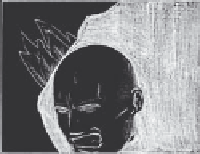Graphics Reference
In-Depth Information
method animation, but it's not about reproducing real life. It's more about giving the character
a comprehensive and disciplined physical lexicon. The Elizabethan fashions emphasised the
male legs, which must have played a signii cant part in their body language. In this tiny i lm, I
exploited every part of Shakespeare's body to tell the story.
Costume designs for a Shakespeare play were required by my school art exam, and here I
started playing with the idea, hugely exciting to me but hardly a radical thought, that costumes
could be an extension of the character. I chose
The Taming of the Shrew
, and I had only seen
the Zef erelli i lm, which clearly had a seemingly endless budget. Reading the play it seemed
that Katherine, i ery Kate, was constantly moving, usually hurling things at Petruchio or
chasing suitors away. With not the greatest of subtlety I gave Kate a l ame-coloured dress,
while her sister Bianca was less colourful. Yes, all rather obvious, but I wanted to emphasise
the movement, and designed a variety of layers, folds, trailing sleeves and ribbons that were
easily agitated. I was pleased with that, although today I would be more subtle with red. In
my work it is never a friendly colour. I would probably now give Kate an outwardly sober dress
which, when provoked, would reveal shocking slashes of unexpected scarlet. This would be a
nightmare with stop motion, as anything to do with dresses spells trouble. For every frame the
dress itself needs to be lifted up, to get to the feet, and then lowered. This is alright if the dress
and the character are moving, as whatever jitter there is can be absorbed into the movement.
A more drastic way is not to bother with legs at all, but have a more solid padded dress, with
some sort of mechanics that simulates a walk with a rise and fall. Clothes cut so tight so as
not to allow any movement do not appeal, but they are an answer. This would limit your
movement, and probably mean another version should the puppet sit down. I would rather
battle with an awkward but l owing dress than one with no movement, making the character
look like a toilet-roll cover and sliding round as on ice. A wired hem, small magnets in the hem
or lining the fabric with thin foil are probably the best ways to animate a dress.
Making costumes say something about the characters may not be realistic, but it conveys
character traits quickly when we have so little time. I have always enjoyed stories of how
costumes have been used in the theatre: in
Phantom of the Opera
, the sleeves of the phantom's
jackets are traditionally made shorter to emphasise the hands, which are such an important
part of his performance, especially with a mask hiding much of his face. As Evita dances with
Che, denying her illness, the costume she wears is an uneasy combination of black and dark
green, saying more about her than she would admit. In productions of
Candide
, the old woman
deprived of one buttock usually has a large, lopsided, hooped skirt along with a lopsided wig.
In drawn i lms, costumes are usually disappointingly simple, uncluttered, lacking any
interesting use of texture or colour, owing to the sheer amount of work involved in animating
anything complicated. The artists use the outlines and costume silhouettes to make their
statements. A silhouette is much easier to keep consistent than complex patterns on a dress
and is perhaps more instantly identii able. With stop motion, we have the luxury of ini nite
textures and colours, although we have problems making small fabric not look like heavy
hessian when blown up on the big screen. Most fabrics have to be printed to the
right scale, as bought patterns betray their size. As with most things in animation,
an element of illusion is necessary, and with costumes, it is giving the illusion that
this piece of lightweight fabric is actually much larger and heavier. Small costumes
do not hang in the way that they would on a full-scale performer, so any help in
the cutting or with weights goes a long way towards preventing them sticking out
unnaturally.


Search WWH ::

Custom Search